Knee Replacement Surgery Arizona
The knee is a very important part of human mobility and is comprised of three bones. The femur, tibia, and patella, or simply put, the thighbone, shinbone, and kneecap, meet together to create the knee. To keep your bones from grinding against each other, there are pieces of cartilage known as meniscus. The meniscus protects the knee by the bones in place and serving as impact support. There are several reasons one may need to undergo knee surgery, such as a tear to the ACL, MCL, or Meniscus, Baker’s Cyst, Patella Tendonitis, Osteoarthritis, Degenerative Joint Disease, Patellofemoral Pain Syndrome, a knee replacement, and other situations.
Knee Arthritis & Knee Replacement
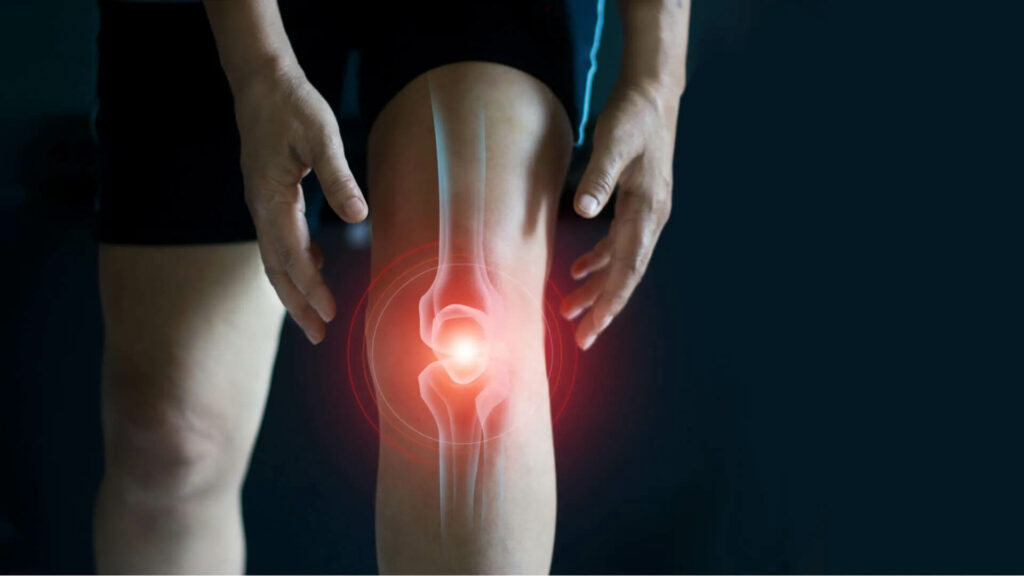
Orthopedic Surgery Solutions for Knee Arthritis & Replacement
Arthritis is swelling within a joint, in this case, the knee. Discomfort, pain, inflammation, and rigidness are the most common symptoms of arthritis. Depending on the severity of arthritis, a partial or total replacement may be necessary. There are three common types of knee arthritis being osteoarthritis, rheumatoid arthritis, and posttraumatic arthritis. Osteoarthritis, known as “wear and tear” arthritis, progresses gradually with increased discomfort as time goes on. Rheumatoid arthritis affects the same joints, meaning both knees will have arthritis pain. As rheumatoid arthritis is “autoimmune,” even healthy cartilage and ligaments will be struck by the immune system. Posttraumatic arthritis is inflammation and caused by a significant knee injury. Bone fractures, ligament tears, and muscle tears can all cause posttraumatic arthritis later on in life.
ACL
ACL
The ACL is located in the center of the knee at a slight diagonal angle. The ACL is what keeps the tibia from slipping up in front of the femur. Additionally, the ACL maintains revolving steadiness for the knee. Most ACL injuries impact articular cartilage, meniscus, and other ligaments, but not always. A ligament injury is known as a sprain and graded on a scale from one to three. Most ACL tears are complete or almost complete tears, with partial ACL tears being uncommon. An ACL injury normally occurs when directions are changed to quickly, abrupt stops occur, landing from a high impact jump awkwardly, and even decelerating while running. High impact crash, such as a body check in hockey or a forceful hit in football can injure an ACL as well.
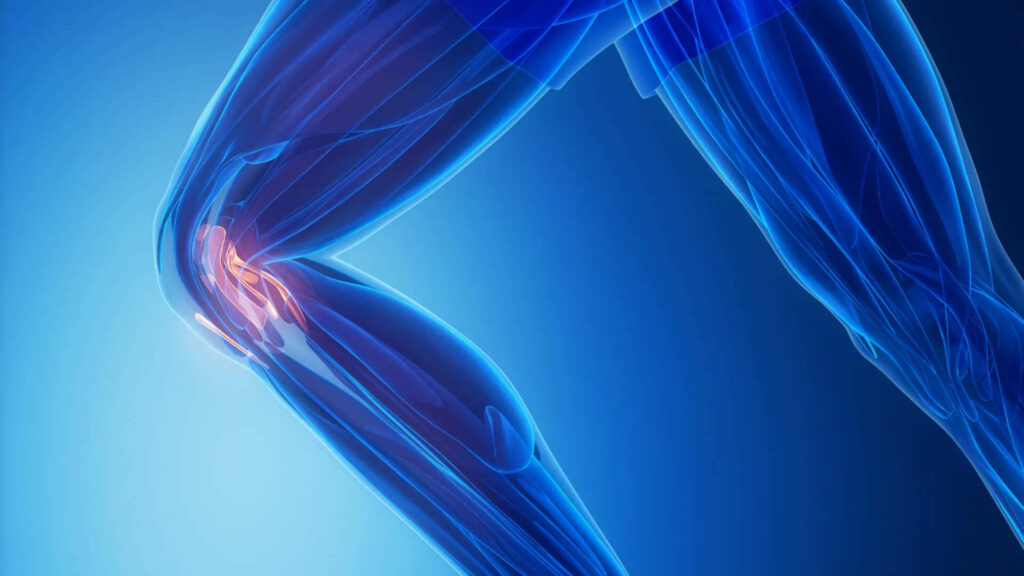
Baker's Cyst
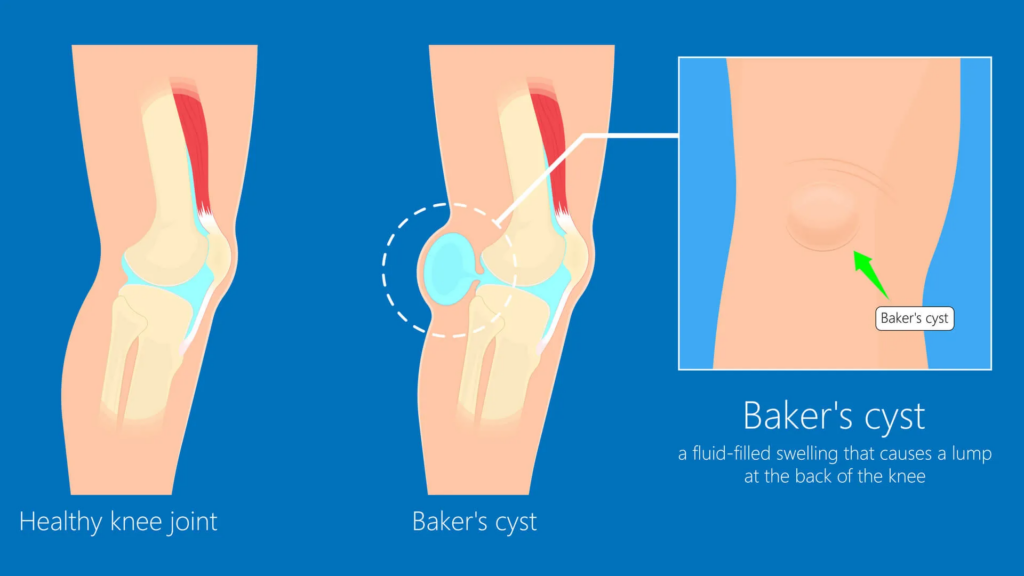
Orthopedic Surgery Solutions for Baker's Cyst
A Baker’s cyst, referred to as a popliteal cyst, is a pack of synovial fluid resulting in swelling and a sensation of stiffness in the back of the knee. The knee produces synovial fluid to assist motion and decrease the amount of friction towards the knee’s moving components. Most often caused by arthritis and abrasion or tear to the cartilage, it is normal for the discomfort or pain to increase when the knee’s full range of motion is exerted, such as walking, running, or riding a bicycle. This issue ends up making the knee create an excess amount of synovial fluid, leading to the onset of a Baker’s cyst. Not often, but possible, the Baker’s cyst will break open, causing synovial fluid to flow towards the calf. This will create swelling in the calf and a knifelike sensation in the knee. The most common culprit of a meniscus tear is hearing a “pop.” Surprisingly, the human body is still able to walk with a torn meniscus and it isn’t until about two to three days after the tear when the knee will grow stiff and swollen. Should you experience yourself reaching for a “locked up” knee, a knee “giving out” on you, or simply cannot extend your knee fully, you may have a meniscus tear. If left untreated, a torn part of the meniscus has the ability to float into the joint. The knee may steadily increase in the occurrences of locking up, popping, and slipping around.
Knee Cartilage Abrasion
Orthopedic Surgery Solutions for Cartilage Abrasion
Cartilage abrasion in the knee is when the articular cartilage, smooth tissue surfacing bones where joints are located, within the knee becomes defective. The articular cartilage essentially lubricates the knee, allowing bones to move with the least amount of friction possible. Cartilage tends to wear away over time, however injury can ruin it as well. Damaged cartilage does not repair well on its own as there aren’t any blood vessels, fortunately, doctors have established methods of promoting cartilage growth, specifically hyaline cartilage, the main part in a joint’s surface. Repairing cartilage has the potential to alleviate pain and lead to better performance in a joint. Additionally, repairing cartilage can slow or even stop the progression of arthritis.

Meniscus Bucket Handle Tear
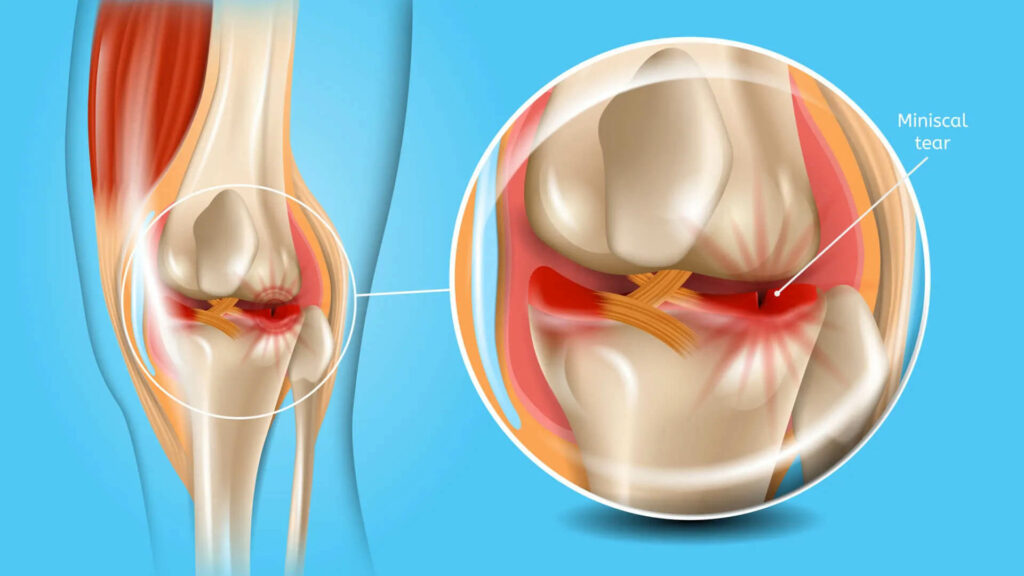
Orthopedic Surgery Solutions for Meniscus Bucket Handle Tear
Tears receive their name based on the appearance of the tear and where the tear originates in the meniscus. A bucket handle tear originates on the outside of the cartilage and has a vertical tear through the meniscus. While parts of the meniscus are not torn, the torn outside cartilage will “pull” into the middle of the knee. The bucket handle tear got its name as the torn piece of cartilage shapes into what looks like a “handle.” An MRI is used to double check the type and location of the tear. An MRI reveals a bucket handle tear obviously, as the torn meniscus will be next to the posterior cruciate ligament (PCL), making it seem you have two of the same ligament. Unfortunately, a bucket handle tear goes hand in hand with an anterior cruciate ligament (ACL) tear, most notably in a contact-sport injury.
Meniscus Radial Tear
Orthopedic Surgery Solutions for Meniscus Radial Tear
The meniscus is a piece of rubber-like cartilage in the knee situated within the femur and tibia, or thigh bone and shin bone. This “C” shaped cartilage helps disperse impact and displace force exerted upon the knee while walking, running, and other mild to high-energy and impact motions. There are several kinds of meniscus tears, most of which can be determined with an MRI. A radial tear is extremely usual. Radial tears are found on the inside of the meniscus along the avascular. Radial tears originate from the inside, free edge of the meniscus and spread across the short axis (from the inside of the “C” and across horizontally). A complete radial tear is known as a transection. As there is no blood supply flowing to the avascular, these tears have a small chance of healing on their own.
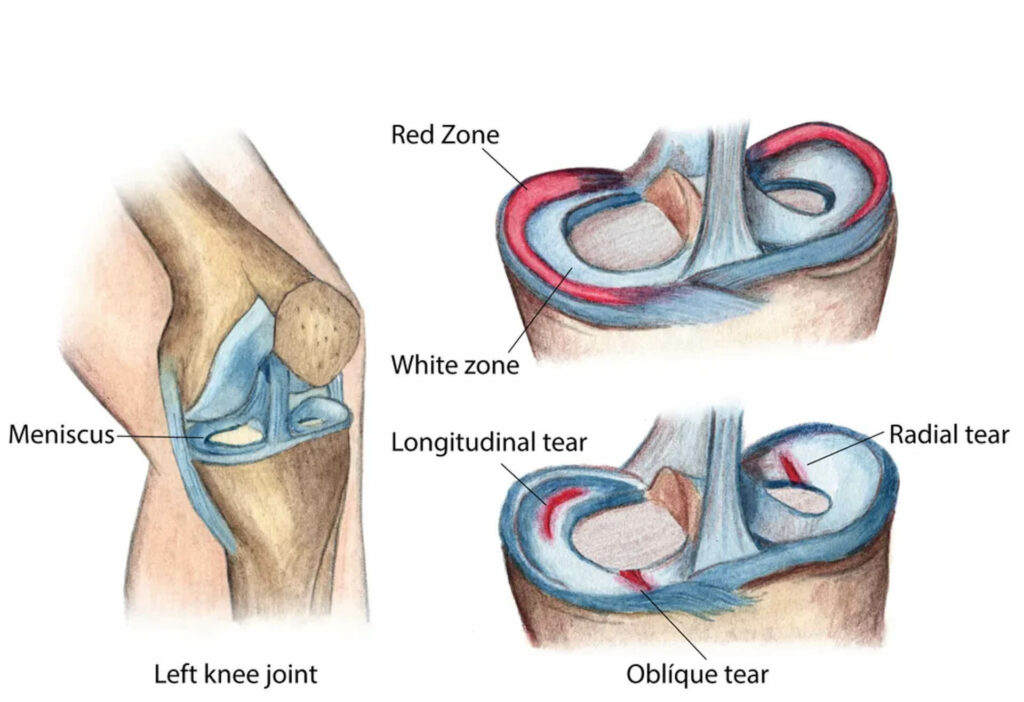
Patella Tendonitis
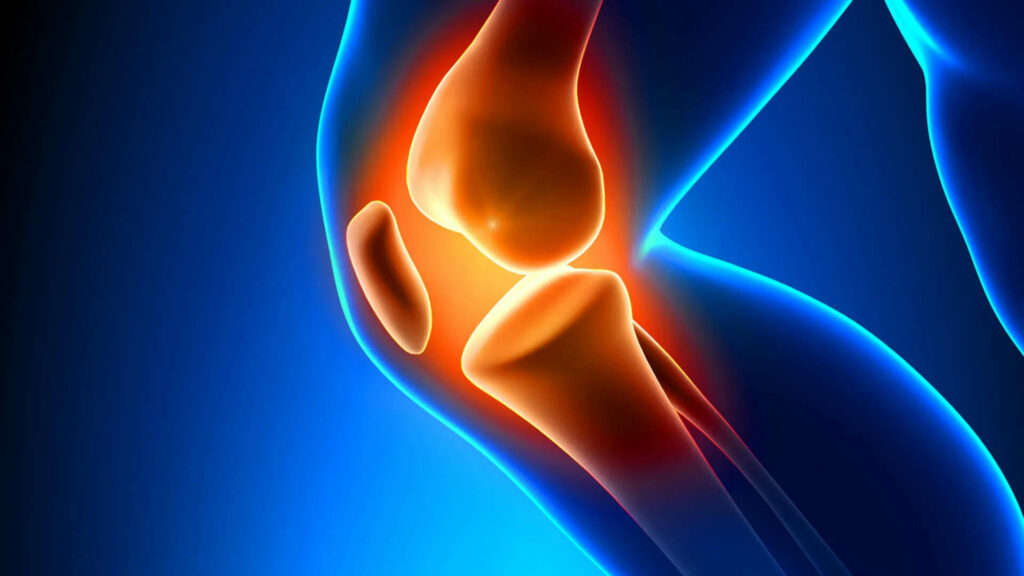
Orthopedic Surgery Solutions for Patella Tendonitis
Patella tendonitis, also known as Jumper’s Knee, is when the patellar tendon, the tissue which connects the patella (kneecap) to the tibia (shinbone), is injured. The function of the patellar tendon is to work alongside the front thigh muscles, such as your quadricep and others, to be able to stretch the knee to be able to kick, run, and jump. Athletes who jump often, like basketball and volleyball players, are most susceptible due to the repeated stress exerted on the knee. Rest and physical therapy exercises combined with stretching can rehabilitate the stressed and weakened knee. It is imperative to keep loose and balanced as tight leg muscles and imbalanced leg strength can cause patella tendonitis.
Knee (DJD) Degenerative Joint Disease
Orthopedic Surgery Solutions for Degenerative Joint Disease
Degenerative joint disease (DJD), referred to as osteoarthritis (OA), is a condition when the knee’s cartilage is worn away over time. While age and genetic predisposition are uncontrollable, the best thing you can do is to maintain a healthy weight to prevent the onset of osteoarthritis.

Knee Osteoarthritis
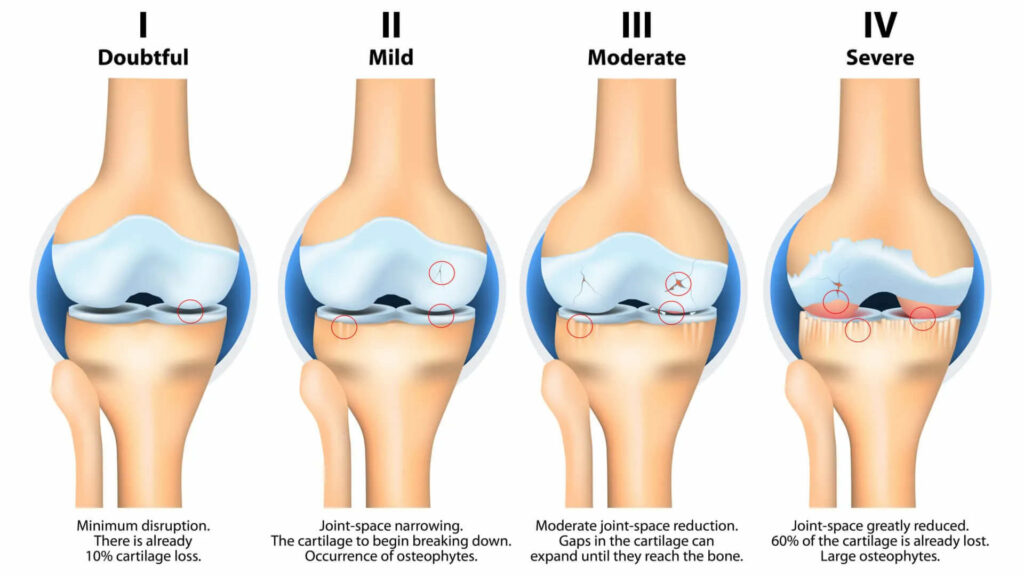
Orthopedic Surgery Solutions for Knee Osteoarthritis
Osteoarthritis, known as “wear and tear” arthritis, is a rather common problem among middle-aged and senior adults, noticeable at about fifty years of age, but can transpire sooner. Osteoarthritis is most common in joints that carry the weight of the body, such as knees and hips. The cartilage in a weight bearing joint wears away over the years and causes pain, hence why it is more common in older people rather than younger people. As the cartilage damage progresses, everyday tasks can become more challenging due to increasing pain and limited range of motion. In rare cases, joint will have little to no cartilage cushioning bones to where the bones begin to grind against one another. The increased bone-on-bone friction produces osteophytes, known as bone spurs. Knee osteoarthritis is a combination of age, weight, heredity, athletics, multiple stress injuries, metabolic conditions, and even rheumatoid arthritis can develop osteoarthritis.
Patellofemoral Pain Syndrome
Orthopedic Surgery Solutions for Patellofemoral Pain Syndrome
Patellofemoral pain syndrome (PPS), known as “runner’s knee,” in layman’s terms, is when the front of your knee and kneecap hurt. People who run every day or engage in sports or activities requiring jumps and impact experience it the most. Daily life motions, such as running, usage of stairs, or even sitting for an extended period of time, can all enhance the pain. Normally rest, ice, elevation, and compression can remedy the pain. Sometimes, physical therapy is needed to subdue the pain. While there is no certain answer for why patellofemoral pain happens, it is attributed with over usage, lack of muscle or muscle misalignment, previous kneecap injury, or simply knee surgery. More specifically, an anterior cruciate ligament (ACL) repair or reconstruction when your own kneecap tendon is used as the graft. Runner’s knee is most common in teenagers and young adults with women having a higher chance of developing it. As women tend to have a wider pelvis than men, the angle of the bones meeting in the knee joint is increased, increasing the likelihood of developing patellofemoral pain syndrome.



